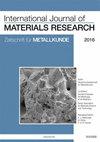(55 - x)TeO2-20ZnO-25B2O3-xEr2O3 玻璃基体的光学、结构和辐射屏蔽特性研究
IF 0.7
4区 材料科学
Q4 METALLURGY & METALLURGICAL ENGINEERING
引用次数: 0
摘要
采用传统的熔体淬火技术制备了掺铒锌硼碲玻璃(EZBT)样品,其摩尔组成为 (55 - x)TeO2-20ZnO-25B2O3-xEr2O3 (x = 0.0, 0.5, 1.0, 1.5 和 2.0 mol.%)。利用 X 射线衍射、傅立叶变换红外光谱和紫外-可见光谱技术对制备的样品进行了表征,以研究其结构、光学和介电性质。为了研究辐射屏蔽能力,使用 WinXCom 软件评估了质量衰减系数(μ m)、半值层(HVL)、有效原子序数(Z eff)等参数。通过 Judd-Ofelt 分析,确定了铒离子 4f 壳内的电子跃迁强度和其他辐射跃迁参数。在 2.0 mol.% 掺铒碲玻璃基体中,能量范围为 (0.01-10) MeV 的 μ m 值为 (108.5-0.03) cm2 g-1。在某些能量下,μ m 和 HVL 值还与传统的普通混凝土和特定的硼酸铅玻璃进行了比较。对目前这种 EZBT 玻璃基体的详细研究对这种 EZBT 玻璃的特定光学和辐射屏蔽应用非常有用。本文章由计算机程序翻译,如有差异,请以英文原文为准。
Study of optical, structural and radiation shielding properties of (55 − x)TeO2–20ZnO–25B2O3–xEr2O3 glass matrix
Erbium doped zinc boro-tellurite (EZBT) glass samples with molar composition of (55 − x)TeO2–20ZnO–25B2O3–xEr2O3 (x = 0.0, 0.5, 1.0, 1.5 and 2.0 mol.%) were prepared by a conventional melt quenching technique. The prepared samples were characterised using X-ray diffraction, Fourier transform infrared spectroscopy and ultraviolet–visible spectroscopy techniques to investigate the structural, optical and dielectric properties. To study the radiation shielding capabilities, the parameters such as mass attenuation coefficient (μ
m), half-value layer (HVL), effective atomic number (Z
eff) etc., were evaluated using WinXCom software. Judd–Ofelt analysis was carried out to determine the intensity of electronic transitions and other radiative transition parameters within the 4f shell of erbium ions. The μ
m values in a range of (108.5–0.03) cm2 g−1 for energy range (0.01–10) MeV were obtained for 2.0 mol.% erbium-doped tellurite glass matrix. The μ
m and HVL values were also compared with conventionally used ordinary concrete and specific lead borate glass at certain energies. The detailed investigation of this current EZBT glass matrix is very useful in the specific optical and radiation shielding applications of this EZBT glass.
求助全文
通过发布文献求助,成功后即可免费获取论文全文。
去求助
来源期刊
CiteScore
1.30
自引率
12.50%
发文量
119
审稿时长
6.4 months
期刊介绍:
The International Journal of Materials Research (IJMR) publishes original high quality experimental and theoretical papers and reviews on basic and applied research in the field of materials science and engineering, with focus on synthesis, processing, constitution, and properties of all classes of materials. Particular emphasis is placed on microstructural design, phase relations, computational thermodynamics, and kinetics at the nano to macro scale. Contributions may also focus on progress in advanced characterization techniques. All articles are subject to thorough, independent peer review.

 求助内容:
求助内容: 应助结果提醒方式:
应助结果提醒方式:


